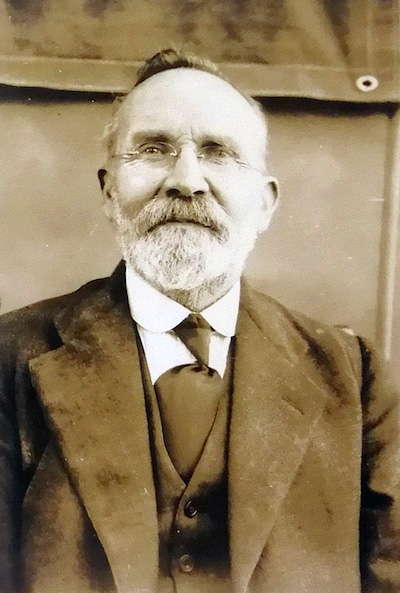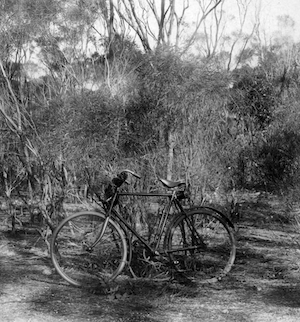Botanical Work
To the memory of
H.B. Williamson
Botanist and Nature Lover
Whose work will Endure1

H.B. Williamson was highly regarded as a botanist and was recognised by his colleagues as an authority on Victorian plants. J.H. Willis, botanist, Assistant Government Botanist, and Acting Director at the Royal Botanic Gardens Victoria and National Herbarium of Victoria from 1937 to 1972, considered him ‘The most important of school teacher botanists’ (Willis, pers. comm. University of Melbourne Herbarium archives). Daley2 noted that “He was indefatigable and thorough in his botanic work: in enthusiasm and method a true disciple of the Baron” [F.J.H. von Mueller].
Williamson was a prolific collector; 6,800 of his herbarium specimens are currently accessioned in Australian herbaria³. Williamson corresponded extensively with colleagues in Victoria and globally and many specimens were also provided to institutions internationally3.
Williamson was elected as Fellow of the Linnean Society, London in 1922². On his passing, in 1931, his collection, including specimens and papers, were gifted to and are accessioned at the National Herbarium of Victoria.



In both his work as a teacher and as a botanist, Williamson demonstrated his interest and skill in mentoring others with botanic interests. “As a botanical correspondent he has helped many, always interested, always patient, always sincere. [...] No one who worked with him could be content with careless nomenclature or “guess” determinations”4. He mentored the aspiring botanist Jean Galbraith, who went on to become a botanist in her own right, and during weekly correspondence from 1922 to 1928, Jean sent and Williamson identified, 608 plant samples5.
Following his appointment as the Keeper of the Herbarium at the University of Melbourne (MELU), Williamson noted “I welcome the appointment at the University because it will give me more scope for passing on advice and material gratis”4.
Not one to dwell on his own accomplishments, it is fitting that those achievements are here stated by his colleagues. Williamson’s significant botanic contributions, described in this exhibition, are a testament to his knowledge of the Victorian flora and his lifelong commitment to foster “a love for our native plants and animals, and a desire to see them protected” 6.

No member of the Club (FNCV) had a more complete knowledge of the State or had made a more extensive study of its flora from the Murray to the sea, and from the 141st meridian to Cape Howe ... Alpine Victoria as far as the Cobberas, the forest region Western plains, central highlands, Gippsland streams and the Mallee district were traversed.
As Mr. Williamson was a good photographer, lanternist, microscopist, and also facile with his pencil, the results of his journeys were readily available to fellow members in an attractive and practical way to supplement oral or written description.
– Charles Daley, The Victorian Naturalist, 1931
May you long be known, as you now are, as the best authority on our local plants. Edward Edgar Pescott, 1922
References
1. Bond RW, Barrett C. Dedication. Victorian ferns: descriptions of all the species occurring in the state: Field Naturalists' Club of Victoria; 1934. p. 2.
2. Daley C. H.B. Williamson: An appreciation. The Victorian Naturalist. 1931;47:172-75.
3. Australasian Virtual Herbarium, [Internet]. Council of Heads of Australasian Herbaria. 2021. H.B. Williamson’s Victorian specimens [cited 2021 Jun 23 ]. Available from AVH website
4. Bell T, Blackwell P, Ashton A. Foliage - the Victorian School of Forestry Herbarium. In: Fry BD, Hateley RF, Youl RM, Forest Education Centenary Committee (Vic.), editors. Circumspice: One hundred years of forestry education centred on Creswick, Victoria. South Melbourne, Victoria: Forest Education Centenary Committee; 2010. p. 125–40.
5. A Country Member. H.B. Williamson: Country Members’ Appreciation. The Victorian Naturalist. 1931;47:203.
6. Williamson HB. The Botany of the Mallee. The Sunraysia Daily [Internet] 1922 Aug 30 [cited 2021 Dec 12].
7. Pescott EE. Letter to H.B. Williamson. MS 9398, BOX 171/18, Australian Manuscripts Collection, Papers, 1854-1931: State Library Victoria, Melbourne, Victoria; 1922 Apr 19.